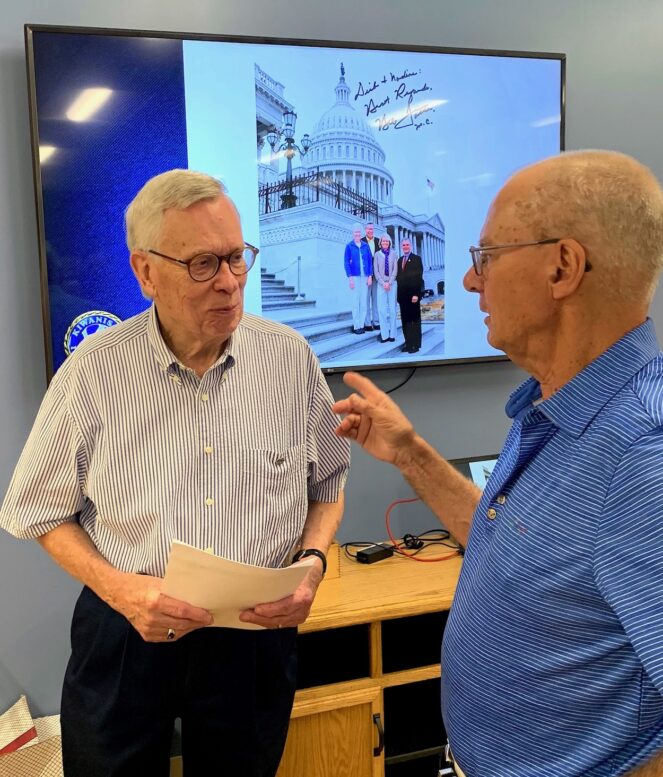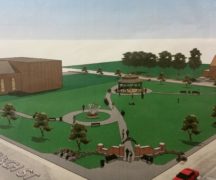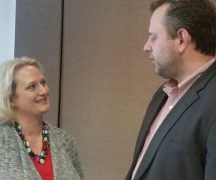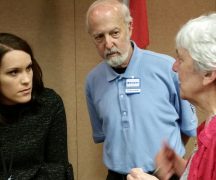By JULIE CARLE
BG Independent News
“We all have stories,” former Bowling Green Mayor Dick Edwards told his peers at a recent meeting of the Bowling Green Kiwanis Club.
Not many people’s stories include shaking hands with the original U.S. astronauts, getting to know Gerald Ford and George W. Bush before they were presidents, and working in Washington, D.C. during John F. Kennedy’s “Camelot” era.
He prefaced his presentation with, “My Washington story is more serendipitous than by design.”
With roots in Bellevue, Ohio, where he and his wife, Nadine, grew up, Edwards said experiences such as Buckeye Boys State and working at the Bellevue Gazette under the watchful eye of his father may have been the key to community ties that led to some of his good fortunes.
During his senior year at Kent State University, Edwards earned the job as a legislative aid for Congressman Charles Mosher, a national, award-winning newspaper editor and publisher, and a Republican from Oberlin, Ohio. Mosher had served in the Ohio Senate for over 10 years and was known for reaching out and working with different groups in support of education and other important causes.
“It was serendipitous because I only knew Charles Mosher in passing. I knew he won by only 4,077 votes, which is not an overwhelming margin,” Edwards said. “The fact that I had the chance to work with him and go to Washington without really knowing one another was done on a hope on his part and a lot of hope on my part that things would work out.”
It was the job with Mosher plus Edwards’ curiosity and ability to easily connect with and relate to others that became the foundation for so many of his fortuitous experiences.
The move to Washington, D.C. in January 1961 was “an interesting start” for the young couple and their infant daughter, Tamra.
“It was an incredibly exciting period. People were coming to Washington with a whole new set of directions and feel and appreciation for government. It was electrifying in JFK’s Camelot era,” and a vast difference in juxtaposition to today’s Washington environment, he stated.
The influx of people into Washington created an environment ripe for forging new relationships, from apartment neighbors to others joining the governmental scene.
Some of his early connections included a staff member for atomic submarine creator Admiral Hyman George Rickover, the head of a nursing home association and a Foreign Service officer from Urbana, Illinois, who had five children and was headed to be an officer in Brazil.
In Mosher’s fourth-floor office of the Cannon Building, Edwards said he moved around quickly and got to know people like Congressman Gerald Ford and his staff.
He had a front seat row to politicians such as Adam Clayton Powell, a powerful orator, handsome guy who always had a bevy of beautiful women on his arm and a Jaguar parked on the street wherever he wanted it; Roland Libonati from Chicago, who had a parade of strange characters go in and out of his office, that “may have had ties to the Chicago mafia”; and Frank Boykin, a wealthy Alabama legislator whose political career ended when he was convicted in a Maryland loan scandal.
As a member of the Bull Elephant Club, an all-male group that was part of the Republican Congressional Campaign Committee, Edwards led two Paul Revere Speaking Tours that connected him to former Michigan Gov. George Romney and Bob Dole, a young Congressman from Kansas at that time.
“I learned a lot about Bob and how he won in Kansas by walking in all those little parades in western Kansas and handing out Dole pineapple juice while the long-sitting member of Congress rode in an air-conditioned limousine.”
Among the highlights in those early D.C. years was being able to wander around the Capitol on his own or take constituents on tours. “I really liked to see and get to know some of the areas beyond the ropes like the Supreme Court Chamber. I loved going there because of the richness of its history,” Edwards recalled.
During their time in D.C., he and Nadine welcomed the opportunity to meet all the original American astronauts including John Glenn, Gus Grissom, Wally Schirra and Alan Shepard. “Being able to shake their hands and look them in the eye was a very exciting and memorable moment,” he said.
His fascination with news media and press conferences gained him and Nadine access to two JFK press conferences. They were starstruck seated among nationally recognized news reporters such as Sander Vanocur of NBC News and Mary McGrory of the Washington Star. But the real thrill was watching and listening to Kennedy. “He was absolutely magnetic and being so close to him was really something. Somehow, we were lucky enough to experience that.”
Nadine’s recollection of Kennedy was similar. “I was mesmerized by his appearance. He was perfect. The charisma he had when he was talking made you feel like you were the only person in the room.”
The Edwards were able to share many memorable moments with their daughter, including a private invitation to see the Mona Lisa. First Lady Jacqueline Kennedy was able to secure an exhibition of the painting on loan from the Louvre to the National Gallery.
“Tamra broke up the crowd when she said, ‘Daddy, can we take her home?’” The introduction to such great art at an early age has stayed with her, he said.
A different art piece made for another memorable experience. Edwards, who was involved in the Battle of Lake Erie sesquicentennial celebration in 1963, was fascinated with the Lake Erie battle. He learned that Mrs. Kennedy had purchased a mantelpiece that depicted the Battle of Lake Erie from an antique dealer in Philadelphia. The artwork was displayed in the Kennedy family dining room at the White House. A call to the White House explaining his involvement with the sesquicentennial commission that had been established by JFK, netted him an invitation to visit the White House while the family was away for the weekend.
“It was another jaw-dropping experience to be that close to the president. The staff were wonderful to me and could not have been more accommodating,” he said.
Learning about President Kennedy’s assassination hmappened on a day Edwards was to meet with Mosher and some of Kennedy’s top science advisors. “We hadn’t heard anything but we knew something was amiss when we were going to the executive office building and there was nothing moving in Washington, D.C. It was the spookiest time I experienced.”
A call from Nadine confirmed that the unbelievable had happened. About the assassination and JFK’s lying in state, he said, “Those are the things that will never quite leave you.”
Years later during Edwards’ time helping to advance public policy about academic science on the staff of the National Science Foundation, he had the opportunity to get to know Senator Edward “Ted” Kennedy, who was pivotal in supporting funding for science education and research.
After the Kent State shootings in 1970 and after Edwards had been on the executive staff at Kent State, he was asked to help facilitate some work in D.C. Ted Kennedy opened his house in Virginia for a fundraising event in honor of those students that were killed.
Serendipity struck again when he met a young, unknown musician who was walking around playing a guitar at the event. It turned out to be Gordon Lightfoot.
Edwards and President Gerald Ford had the opportunity to meet several years after they were first introduced, and one of the reunions was in Bowling Green. Ford had been invited to speak at Bowling Green State University’s Anderson Arena in 1976.
“The arena was jammed to the hilt,” Edwards recalled. There was a loud noise that was thought to be a gunshot, so Ford was rushed out of the arena. “That was one of those bizarre moments only to find out later that it was a flashbulb that exploded.”





